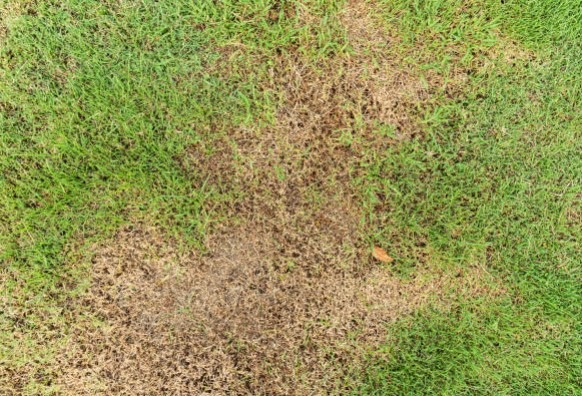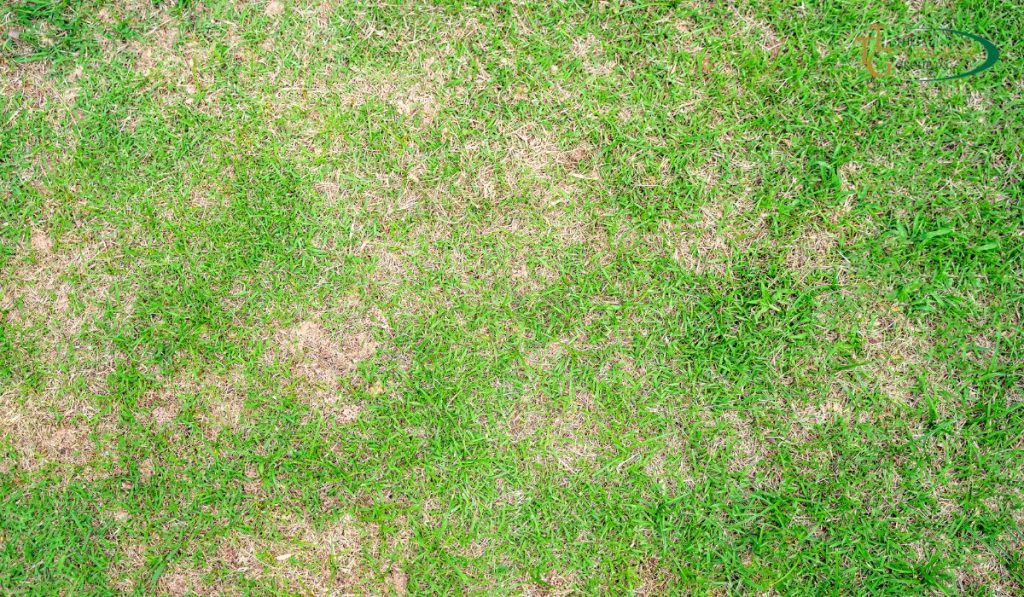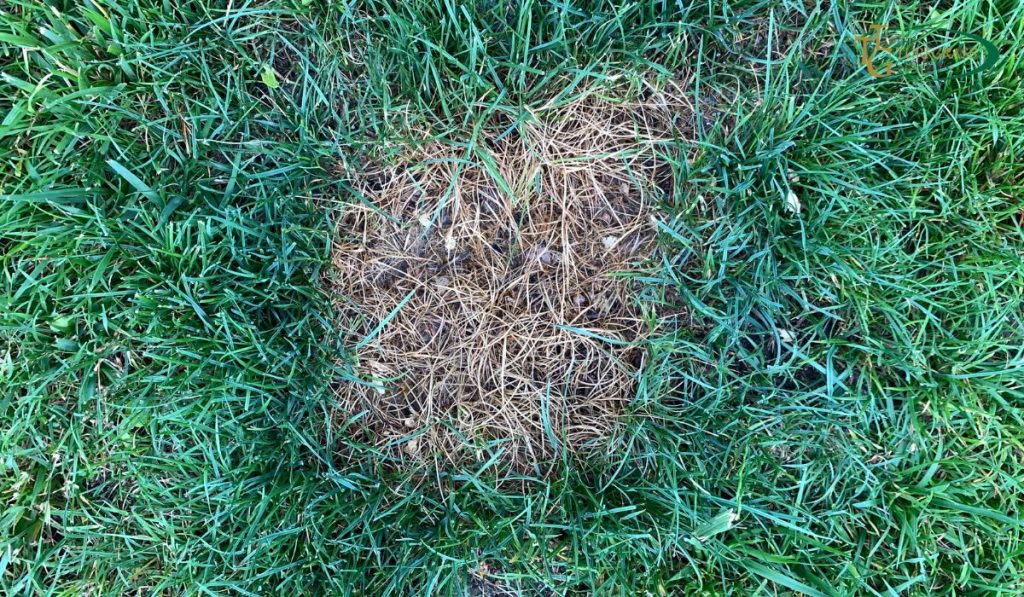
Bermuda grass is one of Georgia’s most popular turfgrass species, but it’s not immune to the dreaded brown patches.
Various factors can cause these unsightly patches, which can be challenging to remove once they take hold.
But fear not, turfgrass enthusiasts!
In this post, we’ll show you how to identify and prevent brown patches on Bermuda grass so you can keep your lawn looking lush and green all season long.
Common Causes Of Bermuda Grass Turning Brown
Before we dive into how to identify and prevent brown patches, let’s take a quick look at some of the most common causes of Bermuda grass turning brown.
One of the most significant factors is overwatering or underwatering.
Too much or too little water can stress the grass and cause it to turn brown.
Poor soil conditions, including lack of nutrients, pH imbalances, and compacted soil, can also contribute to brown patches.
In addition, disease and pests can wreak havoc on Bermuda grass.
Brown patch disease is a common culprit, particularly in humid climates.
This fungal disease attacks the blades of the grass, causing them to turn brown and die.
Other pests, including grubs and chinch bugs, can damage the grass and lead to brown patches.

How To Identify Dead Spots On Bermudagrass?
Identifying dead spots on Bermuda grass is relatively easy.
Look for areas of your lawn where the grass is brown or yellow and appears to be dying.
You may also notice that the affected areas feel spongy or mushy when you walk on them.
This is a sign that the roots of the grass have been damaged, likely due to overwatering, disease, or pests.
If you’re unsure whether you have brown patch disease or another issue, you can take a closer look at the blades of the grass.
Brown patch disease typically causes a distinctive “smoke ring” pattern on the blades, where the outer edge of the blade is brown and the center is green.
Other diseases may cause different patterns, so it’s always best to consult a professional if you need more clarification.
Solutions For Brown Patches On Turfgrass
Now that you know what causes brown patches and how to identify them, let’s talk about how to eliminate them!
Depending on the cause of the brown patches, you may need to take different approaches.
You must adjust your watering schedule if your brown patches are caused by overwatering or underwatering.
Aim to water your lawn deeply and infrequently rather than lightly watering it daily.
This will encourage the roots to grow deeper and become more resilient.
If poor soil conditions cause your brown patches, you may need to amend your soil with nutrients or adjust the pH level.
A soil test can help you determine what changes need to be made.
You’ll need to take more aggressive measures for brown patches caused by disease or pests.
Fungicides can be effective against brown patch disease, but they must be applied at the right time and in the right way.
A professional lawn care company can help you determine the best course of action.
Steps To Prevent Brown Patch Disease In The Future
Preventing brown patch disease and other issues is always preferable to treating them after they’ve already taken hold.
Here are some steps you can take to keep your Bermuda grass healthy and vibrant:
- Water your lawn deeply and infrequently, rather than watering it lightly every day.
- Aerate your lawn regularly to prevent soil compaction.
- Fertilize your yard with a balanced fertilizer to promote healthy growth.
- Monitor for signs of disease or pests and address them promptly.
Conclusion
You can keep your Bermuda grass looking green and healthy all season long with some care and attention.
By identifying the common causes of brown patches and taking steps to prevent them, you can ensure that your lawn is the envy of the neighborhood.
Remember to water deeply and infrequently, aerate your lawn regularly, and watch for signs of disease or pests.
If you do notice brown patches on your lawn, don’t panic!
Solutions are available whether you need to adjust your watering schedule, amend your soil, or use fungicides to combat disease.
If you need help with what’s causing the problem, feel free to consult with a professional lawn care company.
You can keep your Bermuda grass looking beautiful and healthy with effort and knowledge.

Say goodbye to those brown spots and hello to a lush, green lawn!
And if you need to replace your turf, give us a shout!
The Turfgrass Group is here to provide the finest Bermuda grass cultivars to meet your needs.
FAQs
Q: How do you fix brown patches on Bermuda grass?
A: The solution for brown patches on Bermuda grass will depend on the underlying cause. However, some general tips to help improve the condition of your lawn include proper watering, fertilization, and aeration. Additionally, you may need to apply fungicides, insecticides, or other treatments to address specific issues.
Q: What does fungus on Bermuda grass look like?
A: Fungal infections on Bermuda grass can appear as circular or irregularly shaped brown or yellow grass patches. The patches may also have a “smoky” or grayish appearance, and you may see fungal growth or spores on the blades of grass.
Q: Why is my Bermuda turning brown in summer?
A: Bermuda grass is known for its drought tolerance, but extended periods of heat and lack of water can cause the grass to turn brown. Overwatering can also contribute to brown patches, so balancing your watering schedule is essential.
Q: How do you treat Bermuda grass fungus?
A: Treatment for Bermuda grass fungus may include using fungicides, improving drainage, reducing humidity, and proper maintenance practices like mowing and fertilization. Be sure to read and follow the instructions on any fungicide product you use.
Q: How long does grass recovery from brown patches take?
A: The recovery time for brown patches depends on the damage’s severity and the treatment’s effectiveness. In some cases, grass may recover in a few weeks, while in more severe cases, it may take several months.
Q: Why is my Bermuda grass dying in patches?
A: There are many possible causes of patchy Bermuda grass, including insect infestations, disease, nutrient deficiencies, and environmental factors such as heat and drought. It’s essential to identify the specific cause to treat the problem effectively.
Q: What does overwatered Bermuda look like?
A: Overwatered Bermuda grass may appear yellow or pale green, with a thin or sparse appearance. The grass may feel spongy or mushy, and you may notice an unpleasant odor.
Q: Why is my lawn brown even though I water it?
A: Brown patches on your lawn could be caused by various factors, including drought stress, nutrient deficiencies, insect damage, disease, or other environmental factors. Consult a lawn care professional to help you identify the underlying cause and find a solution.
Q: Will fertilizer help brown grass?
A: Fertilizing your lawn can help promote healthy growth and reduce the appearance of brown patches. However, using the correct type of fertilizer and following proper application techniques is essential to ensure your grass is not over-fertilizing or burning.
Q: Can brown grass turn green again?
A: Depending on the underlying cause of the brown patches, your grass may be able to turn green again with proper care and treatment. However, it’s essential to identify and address the underlying issue to ensure your lawn stays healthy and green.
Q: Why is my Bermuda grass brown after I mow?
A: Brown patches on Bermuda grass after mowing could indicate mower damage or an underlying issue such as disease or insect damage. Be sure to mow your grass to the appropriate height and take steps to prevent or address any potential problems.
Q: What is the best fungicide for a brown patch?
A: Many different fungicides are available for treating brown patches on Bermuda grass. The best product will depend on the specific fungus type and the infection’s severity. Consult with a lawn care professional or follow product instructions carefully.
Q: Will lawn fungus go away on its own?
A: Lawn fungus may go away on its own if the conditions that caused the infection are addressed, and the grass is given proper care and treatment. However, in some cases, the infection may persist or spread if left untreated, leading to more severe damage to your lawn. Identifying the specific type of fungus and taking appropriate steps to address it promptly to prevent further damage is essential.